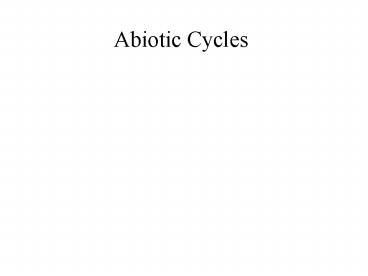Abiotic Cycles - PowerPoint PPT Presentation
1 / 15
Title:
Abiotic Cycles
Description:
Abiotic Cycles Water Cycle Water exists in the ocean (75%), rivers, lakes streams, underground aquifers, and the atmosphere. The water cycle is the how water moves ... – PowerPoint PPT presentation
Number of Views:169
Avg rating:3.0/5.0
Title: Abiotic Cycles
1
Abiotic Cycles
2
Water Cycle
- Water exists in the ocean (75), rivers, lakes
streams, underground aquifers, and the
atmosphere. - The water cycle is the how water moves between
these places. - 5 ways
3
Evaporation
- water returns to the atmosphere from lakes,
rivers, oceans, etc in the form of vapor.
4
Transporation
- water returning to the atmosphere in the form of
vapor from plants
5
Condensation
- Water vapor becomes liquid in
- the form of clouds
6
Precipitation
- Liquid water from clouds falls back to earth as
rain, sleet, snow, or hail
7
Run Off
- Water from precipitation flows back into lakes,
rivers, streams, ocean, etc.
8
Carbon Cycle
- Carbon cycles from the atmosphere to organisms
and back
9
Photosynthesis
- Plants use carbon in carbon dioxide from the
atmosphere to make glucose.
10
Cell Respiration
- Consumers get carbon from glucose by eating
plants. - Consumers then use the glucose to make ATP and
carbon is returned to the atmosphere as carbon
dioxide.
11
Fossil Fuels
- When organisms die, their bodies have trapped
carbon in them. - They eventually decay into petroleum
- When we burn petroleum based fossil fuels (gas,
oil) we release the trapped carbon as carbon
dioxide.
12
Nitrogen Cycle
- Nitrogen cycles from the atmosphere into the
ground, into organisms, and back. - We use nitrogen to make our nucleic acids
- Almost 80 of air is made of nitrogen, but it is
in a form we cannot use.
13
Nitrogen Fixation
- Bacteria that live in soil and in some plant
roots (beans, peas) can turn nitrogen from the
air into a form plants can absorb. - Lighting can also do fixation
14
Ammonification
- Consumers get nitrogen by eating the plants
- When consumers die or release waste, decomposers
return nitrogen to the soil (ammonification)
15
Denitrification
- Some bacteria specialize in breaking down
nitrates and returning nitrogen to the atmosphere.































